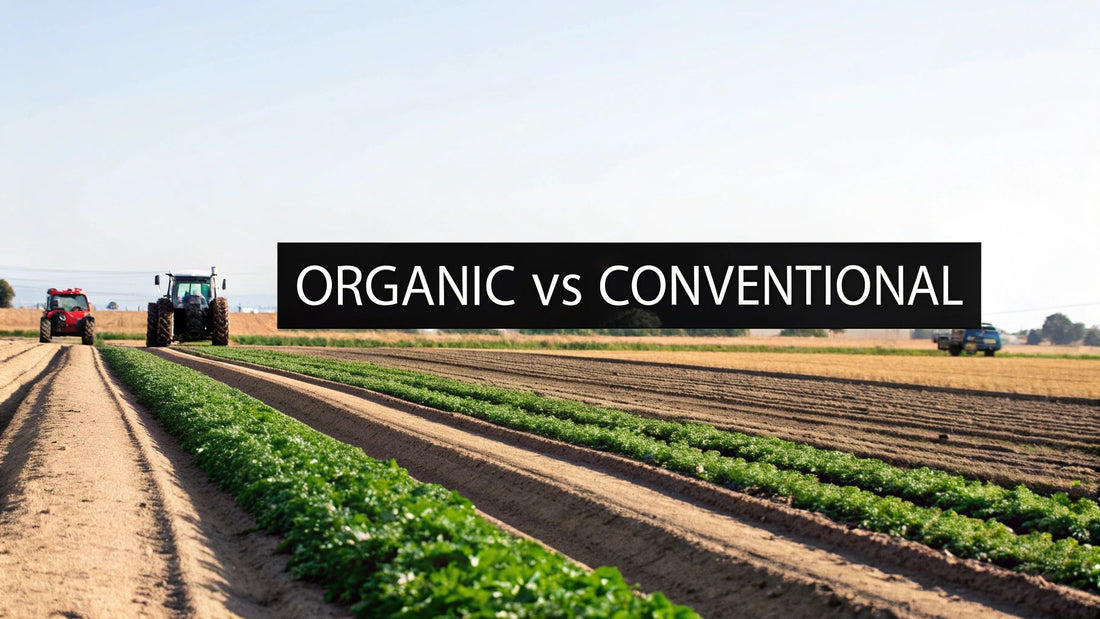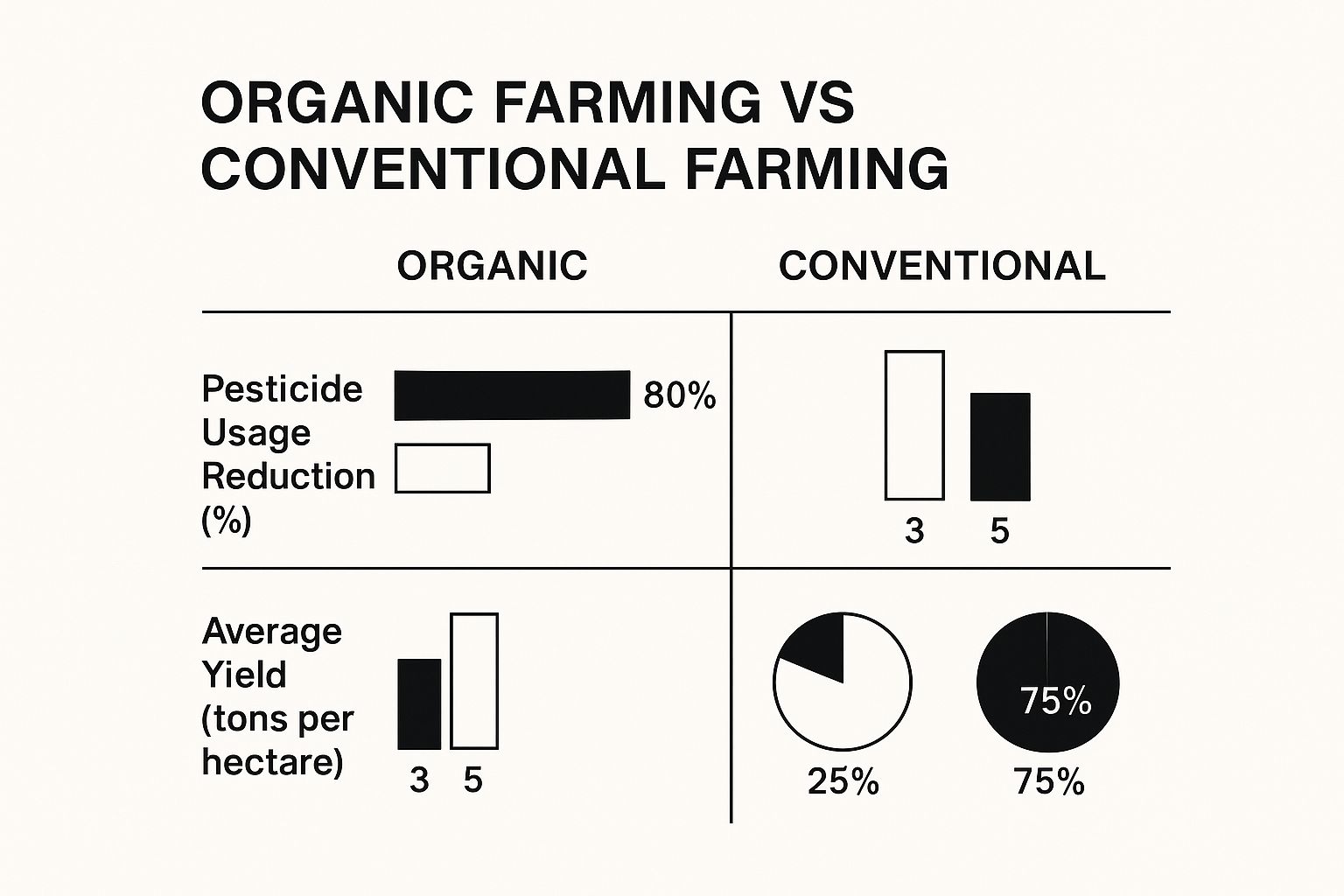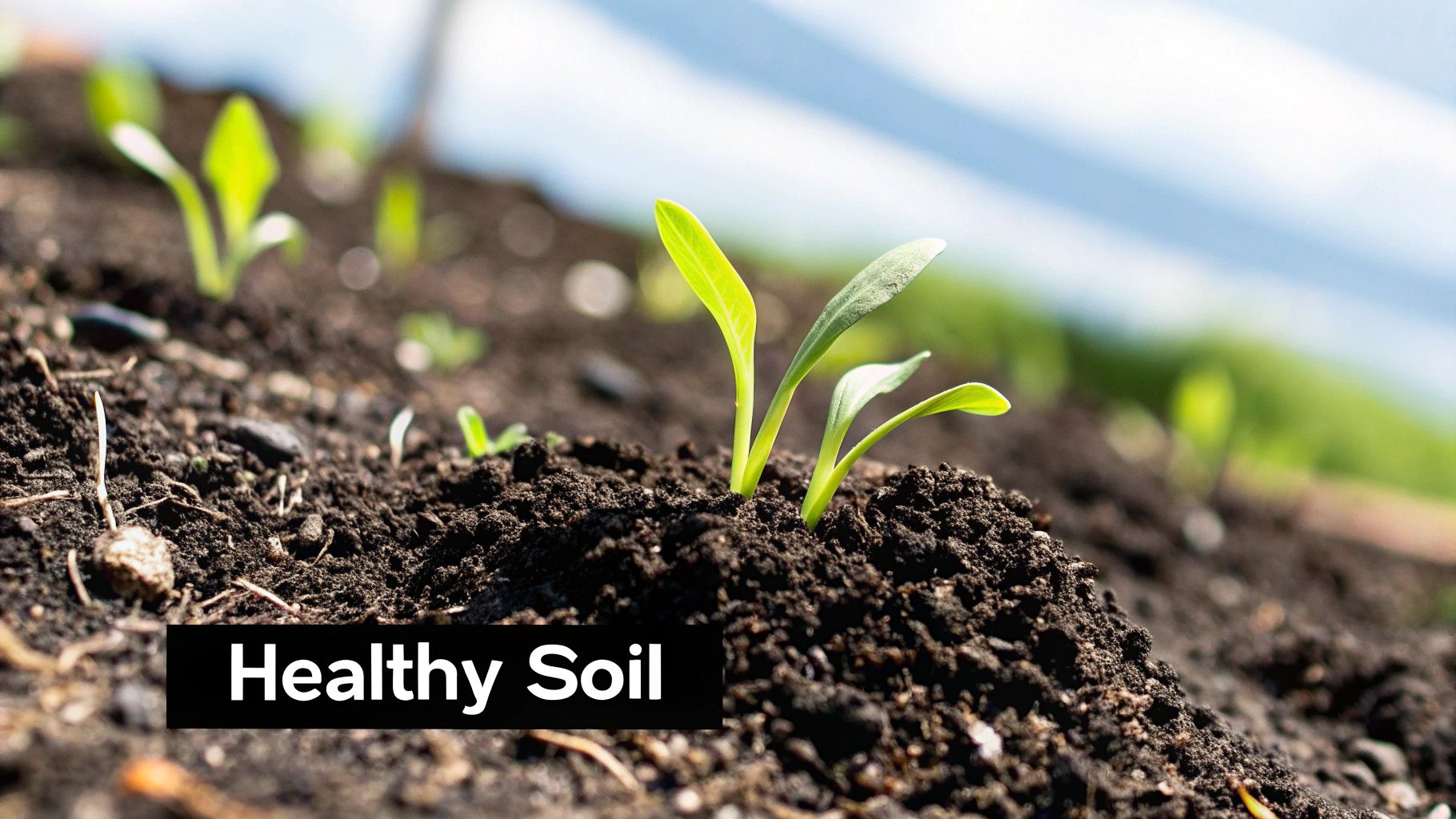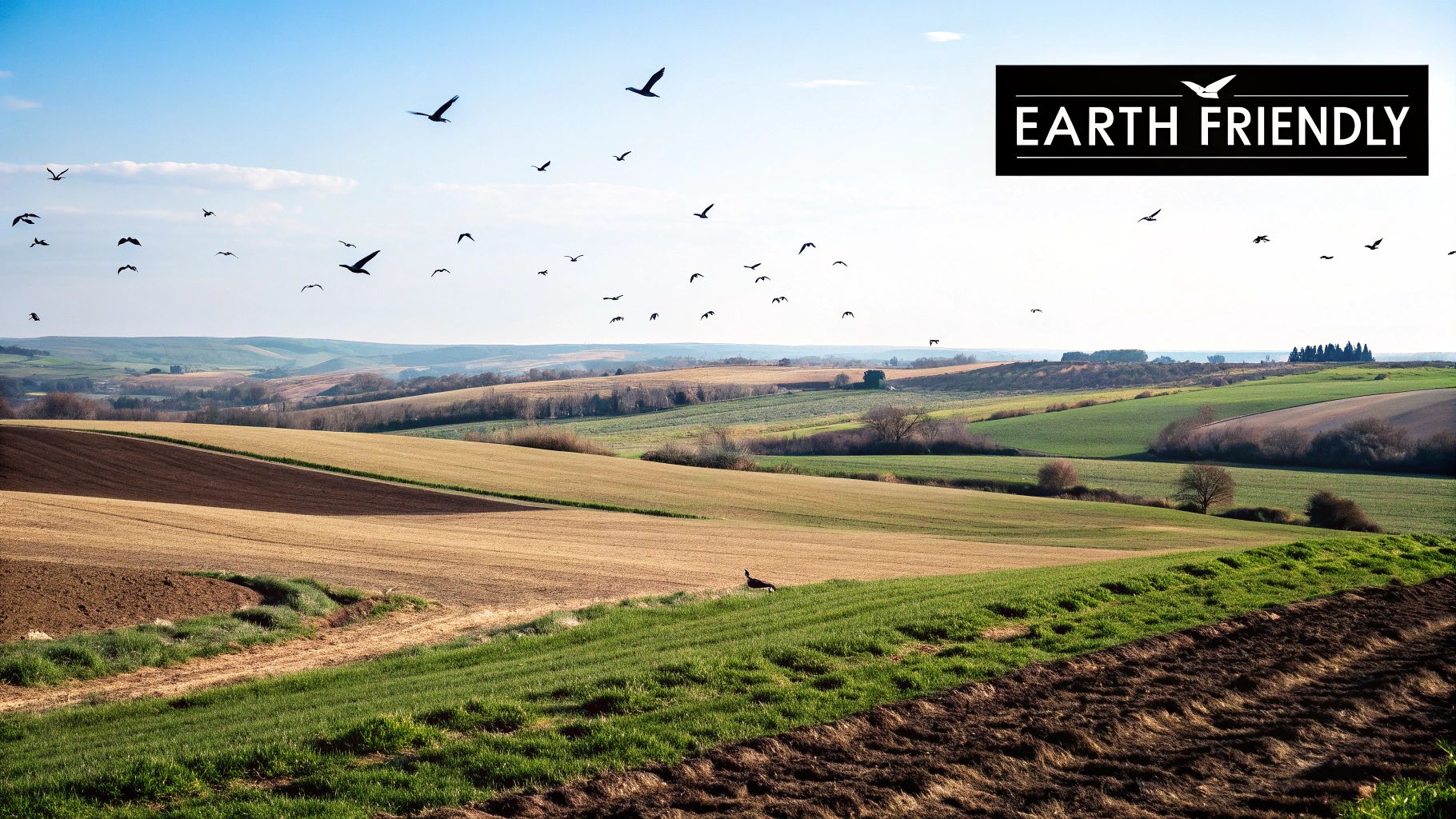
Organic Farming vs Conventional: Which Is Better?
Share
When you break it down, the debate over organic vs conventional farming really comes down to a difference in philosophy. Organic farming is all about working with nature. It avoids synthetic pesticides and fertilizers, putting soil health and biodiversity first. Conventional farming, on its end, leans on technology and synthetic inputs to get the most out of every acre.
Understanding the Two Farming Philosophies
At their core, organic and conventional farming are two completely different blueprints for feeding the world. This isn't just a simple debate over which chemicals are used; it's about the fundamental priorities that guide how food is grown. Each approach strikes a different balance between production goals, environmental impact, and long-term sustainability.
Conventional agriculture was built for one thing: massive scale. It uses tools like synthetic nitrogen fertilizers to give plants a direct, immediate shot of nutrients, which encourages rapid growth. To protect those crops, farmers use targeted synthetic pesticides and herbicides to wipe out pests and weeds, ensuring a maximum harvest. This model has been wildly successful in producing huge volumes of affordable food for a booming global population.
Organic farming, on the other hand, operates more like a complete, self-sustaining system. Instead of zeroing in on just the plant, the focus is on the health of the entire farm ecosystem, starting from the ground up. Organic farmers build rich, fertile soil using natural methods like compost, cover crops, and crop rotation. For pests and weeds, they rely on a balanced ecosystem—think beneficial insects, physical weeding, and diverse plantings—rather than reaching for a synthetic spray.
The real difference is in how each system solves problems. Conventional farming tends to apply an external fix, like a chemical spray, to a specific issue. Organic farming tries to build a resilient internal system that can naturally handle those same challenges.
This image highlights a few of the key trade-offs in the organic vs conventional comparison.

As the data shows, organic farming dramatically cuts down on pesticide use, but it also tends to have lower average yields and still only represents a small slice of the global market.
Core Differences Organic vs Conventional Farming
To really understand how these philosophies play out in the field, it helps to look at their methods side-by-side. The table below offers a quick summary of the foundational differences.
| Attribute | Organic Farming | Conventional Farming |
|---|---|---|
| Fertilizers | Natural inputs like compost, manure, and cover crops. | Primarily synthetic, chemical-based fertilizers. |
| Pest Control | Relies on natural predators, crop rotation, and approved botanical pesticides. | Uses synthetic pesticides for targeted pest elimination. |
| Weed Management | Methods include tillage, mulching, and manual removal. | Employs synthetic herbicides for widespread control. |
| Soil Health | Focus on building long-term soil structure and microbial life. | Focus on providing direct nutrients to the plant for the current season. |
This breakdown shows a clear divergence in approach, with organic methods centered on ecosystem health and conventional methods focused on maximizing output for a single growing season.
The demand for organic food just keeps growing. As of 2023, organic farming now covers about 98.9 million hectares worldwide. While that’s a 2.6% jump from the previous year, it still only makes up 2.1% of all agricultural land on the planet, leaving plenty of room to grow. You can dive deeper into these figures in this 2025 report on global organic statistics.
Production Yields and Land Use: The Great Debate
At the heart of the organic versus conventional farming discussion is one tough, unavoidable question: can organic methods actually grow enough food to feed everyone? This isn't just a philosophical debate—it gets right to the core of land use, global food security, and what sustainable agriculture really looks like. The whole conversation usually starts with something called the "yield gap."

Simply put, the yield gap is the difference in how much food each system can produce on the same amount of land. While organic farming has some clear wins for the environment, the numbers on its productivity can be a mixed bag.
On a global scale, organic yields are often lower. Most studies point to an average reduction of around 20% to 25% compared to conventional farms. Of course, this number swings wildly depending on the specific crop and where it's being grown. For a deeper dive into these production metrics, this economic report from the USDA is a great resource.
This difference in yield brings up a major environmental dilemma. If organic farms produce less food per acre, it stands to reason that we would need to convert more natural land—like forests and grasslands—into farmland to feed a growing population. It’s a tricky trade-off.
When the Yield Gap Shrinks
But here's where it gets interesting. That "yield gap" isn't set in stone. The idea that conventional farming always produces more is a huge oversimplification. The real performance of an organic system depends heavily on the crop and the local climate.
For some crops, the gap virtually disappears.
- Legumes: Think beans, peas, and lentils. These plants are special because they can "fix" their own nitrogen in the soil, so they don't miss the synthetic fertilizers as much.
- Perennial Crops: Fruits and other plants that live for many seasons often do just as well, if not better, under organic management over the long haul.
The biggest game-changer, though, is extreme weather—especially drought. This is where organic farming's obsession with soil health really shines. Healthy, organic soil is packed with organic matter, which makes it act like a giant sponge, holding onto far more water than depleted, conventionally farmed soil.
When a drought hits, that extra water retention is a lifesaver. Organic crops can often keep growing strong long after their conventional neighbors have started to wilt. In these tough conditions, it’s not uncommon for organic farms to match or even beat conventional yields.
This natural resilience is a massive advantage in a world facing more frequent and intense weather events due to climate change. It tells us that while conventional methods might win in a perfect year, organic farming is building a tougher, more adaptable system for an unpredictable future.
Long-Term Productivity Is About More Than One Harvest
The conversation about yield also has to look at the long game. Conventional farming often gets its high yields by feeding plants directly with a steady diet of synthetic fertilizers. While effective in the short term, this approach can slowly degrade the soil's structure and natural fertility, making the land dependent on ever-increasing chemical inputs just to maintain output.
Organic farming, on the other hand, is an investment in the future. By focusing on building healthy soil with practices like cover cropping, composting, and reduced tilling, organic farmers create a self-renewing foundation that can support strong yields for generations to come.
So, when we talk about yield, it’s not just one number.
- Conventional systems are often geared for maximum output in the short term, provided the conditions are just right.
- Organic systems really prove their worth with greater resilience, especially when conditions are tough, like during a drought.
- Long-term, conventional yields rely on a constant stream of synthetic inputs, whereas organic yields are built on the renewable resource of healthy soil.
Ultimately, picking a "winner" on yield requires looking beyond a single season's harvest. It’s about evaluating performance across different scenarios, over many years, and weighing the broader impacts on our land and ecosystems. The better system really depends on the goal: are we trying to maximize production today, or are we building a food system that can weather the storms of tomorrow?
Evaluating the Environmental Footprint
When you get right down to it, the environmental impact is often the deal-breaker for many people choosing between organic and conventional farming. This isn't just about what happens on the farm; the effects ripple outwards, touching everything from soil health and water quality to biodiversity and even our climate. Each method leaves a very different mark on the planet.

Conventional farming, with its reliance on synthetic inputs, puts unique pressures on the environment. Take nitrogen fertilizers, for instance. They absolutely boost crop growth, but they're also notorious for nutrient runoff. When that excess nitrogen washes into rivers, it can trigger massive algal blooms that suck oxygen out of the water, creating "dead zones" that devastate fish and other aquatic life.
On top of that, synthetic pesticides and herbicides can bring their own set of problems. While they are very good at killing pests, these chemicals can seep into groundwater, harm beneficial insects, and linger in the environment for years.
Soil Health: The Foundation of Farming
Perhaps the most profound difference between these two systems is found right under our feet, in the soil itself. Organic farming doesn't see soil as just dirt; it's a living, breathing ecosystem that needs to be nurtured.
Practices like cover cropping, composting, and crop rotation are the bread and butter of organic agriculture. They're all about feeding the soil, constantly adding organic matter that improves its structure, helps it retain water, and supports a bustling community of microbes. This focus on building healthy soil pays off in the long run, creating land that's both fertile and resilient.
Conventional farming, on the other hand, can sometimes degrade the soil over time. Frequent, heavy tillage can shatter the soil's structure, leaving it vulnerable to being washed or blown away. The steady diet of synthetic fertilizers can also throw the natural balance of microorganisms out of whack, making the soil more and more dependent on chemical fixes.
Healthy, living soil is one of our best tools for sequestering carbon. Organic farming practices can pull significant amounts of carbon dioxide out of the atmosphere and lock it away underground, which is a huge win in the fight against climate change.
Protecting Water and Wildlife
Water quality is another area where the contrast is stark. Simply by not using synthetic pesticides and fertilizers, organic farms drastically cut down the risk of chemical runoff contaminating nearby water sources. This directly protects aquatic ecosystems and helps keep drinking water safe for local communities.
Organic farms also tend to be bustling hubs of biodiversity. Without broad-spectrum herbicides and pesticides clearing the field, these farms become safe havens for a much wider variety of life.
- A Refuge for Pollinators: The mix of plants and lack of harsh chemicals make organic farms critical sanctuaries for bees, butterflies, and other pollinators we all depend on.
- Corridors for Wildlife: It's common to see hedgerows and natural buffer zones on organic farms, which provide homes for birds, small mammals, and beneficial insects that act as a natural pest control crew.
- Richer Ecosystems: Research consistently shows that organic farms support, on average, 30% more species than their conventional counterparts. This creates a far more balanced and resilient local environment.
This holistic philosophy is really the heart of sustainability. If you're curious to see how farms put these ideas into action, you can explore different farm sustainability practices that connect these dots.
Ultimately, the environmental footprint of conventional farming comes from its focus on maximizing efficiency, which can sometimes lead to pollution and resource depletion. Organic farming, by working with nature instead of against it, offers a more regenerative path—one that builds healthy soil, protects our water, and promotes biodiversity for a more sustainable food future.
The Financial Realities for Farmers and Consumers
For a lot of people, the whole organic versus conventional debate comes down to one simple thing: money. What does it actually cost? It's a tricky question, because the financial impact looks very different for the farmer growing the food than it does for the person buying it at the grocery store. Getting a handle on these economics is essential to understanding the bigger picture.
For farmers, going organic is a serious upfront investment. There's a mandatory three-year transition period where they have to follow all the organic rules but can't yet sell their crops with the organic label—or its premium price. During this time, yields often dip as the soil and local ecosystem recalibrate, which can create a real, though temporary, financial strain.
But once they get that certification, the math starts to change.
The Farmer's Bottom Line
Right away, organic farmers cut out one of the biggest line items in a conventional farmer's budget: synthetic fertilizers and pesticides. They do spend more on labor for things like weeding and on natural inputs such as compost, but the savings on chemical treatments can be huge. This shift in spending is fundamental to the organic business model.
The real game-changer, though, is what people are willing to pay. Consumers consistently shell out more for organic products, which lets farmers command a premium. This isn't just a little extra cash; it's often the key factor that makes the whole operation profitable.
When you combine the savings on synthetic inputs with the higher prices at market, you get a powerful economic incentive. It’s why many organic farms, even with slightly lower yields, can ultimately be more profitable per acre.
The rapid growth of the organic market only reinforces this. The organic agriculture sector has exploded into a robust market, valued at over $150 billion in 2025 and is projected to grow by about 10% each year. One study even found that organic farmers were 22% to 35% more profitable on average than their conventional counterparts, a difference driven almost entirely by that price premium. You can dig deeper into these industry insights on organic farming growth.
Why Consumers Pay More at the Store
From the shopper's point of view, that higher price tag on organic food can be a hurdle. The price difference isn't random; it reflects the genuine costs and unique economic model behind growing food organically. A few key things are driving up the price you see on the shelf.
- More Hands-On Labor: Organic farming just takes more work. Things like pulling weeds by hand, managing complex crop rotations, and spreading compost require more people-power than spraying a field with chemicals.
- Certification and Red Tape: Farmers have to pay for their organic certification every year. These fees cover the inspections and paperwork needed to prove they're meeting the strict standards, and that cost inevitably gets passed along.
- Smaller Scale of Operations: While it's growing fast, the organic sector is still much smaller than conventional agriculture. That means organic farms often can't take advantage of the same cost-cutting efficiencies in processing, shipping, and distribution that massive operations can.
- Careful Post-Harvest Handling: Organic food has to be kept separate from conventional products every step of the way to avoid contamination. This adds layers of complexity and cost to the supply chain.
Government subsidies also have a huge impact on the final price. For decades, conventional commodity crops like corn and soy have received massive government support, which artificially lowers their price on the market. Organic farming has seen far less of that financial help, so its price is a much truer reflection of what it actually costs to produce. This imbalance in support is a big reason why that price gap at the checkout persists.
Impact on Nutrition and Human Health
When we talk about organic versus conventional farming, the conversation almost always turns to a very personal question: which one is actually better for me? The debate really comes down to two things—what organic food doesn't have, and what it might have more of.
The most obvious starting point is pesticides. Conventional agriculture depends on synthetic pesticides to keep crops healthy, but residues can linger on the food that ends up on our plates. While government agencies set "safe" limits for these residues, many people are rightly concerned about the long-term effects of low-level exposure, especially for vulnerable groups like children and pregnant women.
It’s pretty stunning how quickly the body responds to a change. Studies have shown that switching to an organic diet can slash the amount of pesticides detected in a person's system in just a few days. For a lot of shoppers, this peace of mind is the single biggest reason they choose organic.
Unpacking the Nutritional Differences
So, we know organic has fewer synthetic pesticides. But does an organic apple pack more vitamins than a conventional one? The answer here is a bit more nuanced. While the science is still evolving, some clear patterns are emerging, especially when we look beyond basic vitamins.
Because they can't rely on chemical sprays for protection, organic plants are forced to build up their own defenses. This means they often produce higher levels of compounds like antioxidants and polyphenols. It turns out, these same protective compounds that help the plant survive can also offer health benefits to us, like reducing inflammation.
Here’s a look at how the health and nutritional profiles stack up.
Health and Nutrition Profile Comparison
This table breaks down some of the key data-driven differences between food grown with organic versus conventional methods.
| Factor | Organic Food | Conventional Food |
|---|---|---|
| Pesticide Residues | Minimal to none. | Detectable residues are common, though usually within legal limits. |
| Antioxidants | Often has higher concentrations, including phenols and polyphenols. | Generally contains lower levels of these protective compounds. |
| Cadmium | Significantly lower levels of this toxic heavy metal. | Higher concentrations are more frequently found. |
| Nitrogen Content | Generally lower nitrogen levels. | Often higher due to synthetic fertilizer use. |
While you might not see a huge difference in major vitamins and minerals, the variation in these other compounds is significant. It's a direct result of the farming environment itself.
"Because organic plants are not protected by synthetic pesticides, they produce more of their own protective compounds, which are the very antioxidants and phytonutrients that offer health benefits to humans."
Additives, GMOs, and Overall Quality
The health conversation doesn't stop in the field. Certified organic standards also dictate what can and can't be done after the food is harvested, banning several common practices in conventional food processing.
- No GMOs: Genetically modified organisms are strictly forbidden in anything labeled certified organic. This is a non-negotiable for consumers who want to avoid them.
- No Synthetic Additives: You won't find artificial preservatives, colors, or flavors in organic packaged foods.
- No Irradiation: Organic food is never treated with ionizing radiation, a practice sometimes used to kill bacteria and extend shelf life.
These rules provide an extra layer of confidence for anyone looking for food that's as close to its natural state as possible. Ultimately, the value of organic for many people isn't just about what's in it, but also about the long list of synthetic inputs it keeps out of the entire food chain—from the farm to your pantry.
Which Farming Method Should You Support?
When you dig into the organic vs. conventional farming debate, you quickly realize there’s no simple winner. The "best" choice really depends on who you are—a shopper, a farmer, or a policymaker—and what you value most. It’s all about balancing trade-offs between cost, environmental impact, personal health, and the massive challenge of global food security.
For most of us, this decision plays out in the grocery aisle. If your main concern is limiting your family's exposure to synthetic pesticide residues, then reaching for organic produce is a pretty clear-cut choice.
Making an Informed Choice as a Consumer
A smart strategy can help you balance your budget with your priorities. Many people focus on buying organic versions of produce known for higher pesticide loads—the famous "Dirty Dozen" list is a great guide here. On the other hand, for things with thick peels you don't eat, like bananas or avocados, the organic label might be less of a priority for you.
Remember, your wallet is a powerful tool. Every dollar you spend on organic food is a vote for a system that emphasizes soil health and biodiversity, signaling to the market that these practices matter.
Of course, this doesn't make conventional food a bad option. It's affordable, widely available, and essential for feeding billions of people. The goal is simply to be mindful and choose based on what's most important to you and your family.
The Future: A Hybrid Approach
Looking down the road, the future of food probably isn't a clear victory for one side. It’s more likely to be a blend of the best ideas from both camps, often called integrated farming. Imagine using high-tech, precision tools from conventional agriculture to apply natural fertilizers with pinpoint accuracy, or using organic soil-building techniques on a conventional farm to slash water consumption.
This middle path recognizes that both systems have something valuable to teach us. By merging the ecological principles of organic farming with the scalable efficiency of conventional methods, we can build a food system that’s not just productive but truly regenerative. In the end, creating a better food future means getting past the "organic vs. conventional" battle and adopting a smarter, more flexible approach to how we grow our food.
Frequently Asked Questions

As you dig into the organic farming vs conventional farming debate, a lot of questions tend to pop up. Let's clear the air and tackle some of the most common ones so you can feel confident in your food choices.
How Strict Are Organic Certification Standards?
Getting that USDA organic seal is no small feat. It’s a serious commitment that involves a demanding certification process, complete with annual inspections to make sure the farm stays on track.
Before a farm can even apply, its land must be free of prohibited substances—think synthetic pesticides and fertilizers—for three full years. On top of that, farmers have to keep meticulous records and develop an official Organic System Plan, which details exactly how they’ll promote soil health and biodiversity.
The certification process is intentionally thorough to maintain the integrity of the organic label. It’s your guarantee that any product with the USDA seal has met a consistent, federally regulated standard.
Are GMOs Allowed in Organic Farming?
That’s an easy one: absolutely not. Genetically modified organisms (GMOs) are completely forbidden in all certified organic products. This isn't just a minor rule; it's a cornerstone of the entire organic standard.
The ban covers everything from the seeds planted in the soil to the ingredients in processed organic foods. For many people, this non-GMO guarantee is a huge reason they choose organic, offering a simple way to avoid genetically engineered ingredients without scrutinizing every label for a separate certification. It's a key differentiator in the organic vs. conventional farming discussion.
Does Natural Mean the Same as Organic?
This is a common point of confusion, but the two terms are worlds apart from a regulatory perspective. Understanding the difference is key to making informed decisions at the grocery store.
- Organic: This is a legally protected and regulated term. When you see the USDA organic seal, it means the product was grown and processed according to strict federal rules that protect natural resources and prohibit most synthetic substances.
- Natural: This term is loosely defined and not well-regulated by the FDA (except for meat and poultry). It usually means a product is free from artificial colors, flavors, or synthetic additives, but says nothing about how the ingredients were farmed.
A product labeled "natural" can still come from a farm using conventional pesticides, synthetic fertilizers, and GMOs. Only the "organic" seal gives you that assurance of specific agricultural practices.
At Naked Pantry, our goal is to make it simple to support food systems that are good for you and the planet. We stock our shelves with US-grown organic products whenever we can and ship everything in 100% plastic-free packaging. Ready to build a pantry that reflects your values? Explore our plastic-free pantry staples.
